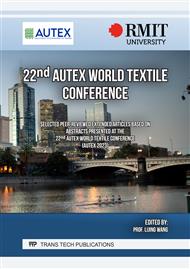[1]
Miller, L.; Mattison, P.; Paul, L.; Wood, L.: The effects of transcutaneous electrical nerve stimulation (TENS) on spasticity in multiple sclerosis. Multiple sclerosis (Houndmills, Basingstoke, England) 13(2007)4, pp.527-533
DOI: 10.1177/1352458506071509
Google Scholar
[2]
Gorman, P. H.: An update on functional electrical stimulation after spinal cord injury. Neurorehabilitation and neural repair 14(2000)4, pp.251-263. https://doi.org/10.1177/ 154596830001400402
DOI: 10.1177/154596830001400402
Google Scholar
[3]
Creasey, G. H.; Ho, C. H.; Triolo, R. J.; Gater, D. R.; DiMarco, A. F.; Bogie, K. M.; Keith, M. W.: Clinical applications of electrical stimulation after spinal cord injury. The journal of spinal cord medicine 27(2004)4, pp.365-375
DOI: 10.1080/10790268.2004.11753774
Google Scholar
[4]
Hausdorf, J.; Ring, H.: THE EFFECT OF THE NESS L300 NEUROPROSTHESIS ON GAIT STABILITY AND SYMMETRY. Journal of Neurologic Physical Therapy 30(2006)4, S. 198 f
DOI: 10.1097/01.NPT.0000281266.34830.4b
Google Scholar
[5]
Bioness Inc., NC 27703, United States: Improved Mobility. Made Easier. https://www.l300go.com, (12 November 2022)
Google Scholar
[6]
HELLER MEDIZINTECHNIK GmbH & Co. KG: Weak foot dorsi flexion – foot drop system innoSTEP-WL provides mobility. https://www.heller-medizintechnik.de/produkte/innostep_wl/?lang=EN, (12 November 2022)
Google Scholar
[7]
Pro Walk Rehabilitationshilfen und Sanitätsbedarf GmbH: The WalkAide®—System. Myo-Orthetic Technology for the Treatment of Centrally Caused Foot Lift Weakness. https://www.prowalk.de/produkte/walkaide/, (20 November 2022)
Google Scholar
[8]
Jansen, K. M. B.: Performance Evaluation of Knitted and Stitched Textile Strain Sensors. Sensors (Basel, Switzerland) 20(2020)24
DOI: 10.3390/s20247236
Google Scholar
[9]
Molinaro, N.; Massaroni, C.; Lo Presti, D., et al.: Wearable textile based on silver plated knitted sensor for respiratory rate monitoring. Annual International Conference of the IEEE Engineering in Medicine and Biology Society. IEEE Engineering in Medicine and Biology Society. Annual International Conference 2018(2018), pp.2865-2868
DOI: 10.1109/EMBC.2018.8512958
Google Scholar
[10]
Tangsirinaruenart, O.; Stylios, G.: A Novel Textile Stitch-Based Strain Sensor for Wearable End Users. Materials (Basel, Switzerland) 12(2019)9
DOI: 10.3390/ma12091469
Google Scholar
[11]
Dunne, L. E.; Gioverto, G.; Coughlin, J.; Bibeau, K.: Machine-Stitched E-Textile Stretch Sensors. Ames: (2013)
DOI: 10.31274/itaa_proceedings-180814-886
Google Scholar
[12]
Park, S. Y.; Lee, J.-H.: Machine Embroidered Sensors for Limb Joint Movement-Monitoring Smart Clothing. Sensors (Basel, Switzerland) 21(2021)3
DOI: 10.3390/s21030949
Google Scholar
[13]
Martínez-Estrada, M.; Gil, I.; Fernández-García, R.: An Alternative Method to Develop Embroidery Textile Strain Sensors. Textiles 1(2021)3, S. 504-512
DOI: 10.3390/textiles1030026
Google Scholar
[14]
Zhao, K.; Niu, W.; Zhang, S.: Highly stretchable, breathable and negative resistance variation textile strain sensor with excellent mechanical stability for wearable electronics. J Mater Sci 55(2020)6, S. 2439-2453
DOI: 10.1007/s10853-019-04189-x
Google Scholar
[15]
Euler, L.; Guo, L.; Persson, N.-K.: Textile Electrodes: Influence of Knitting Construction and Pressure on the Contact Impedance. Sensors (Basel, Switzerland) 21(2021)5
DOI: 10.3390/s21051578
Google Scholar
[16]
Watson, A.; Sun, M.; Pendyal, S.; Zhou, G.: TracKnee: Knee angle measurement using stretchable conductive fabric sensors. Smart Health 15(2020), S. 100092 f
DOI: 10.1016/j.smhl.2019.100092
Google Scholar
[17]
Götz-Neumann, K.: Gehen verstehen – Ganganalyse in der Physiotherapie. 4. Auflage, Stuttgart: Thieme, 2016. – ISBN 9783132401549
DOI: 10.1055/b-003-127005
Google Scholar



